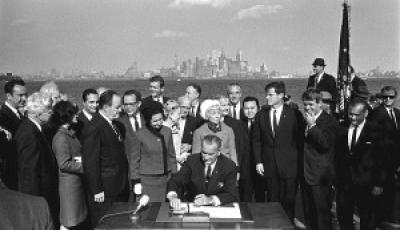US Immigration Laws and the Making of Model Minorities and Illegal Aliens
Posted:
Time to read:
Guest post by Madeline Y. Hsu, Associate Professor, Centre for Asian America Studies, The University of Texas at Austin. This post is the second instalment of the Border Criminologies Themed Week on Race and Border Control organised by Prof Yolanda Vázquez.
In How Race is Made in America: Immigration, Citizenship, and the Historical Power of Racial Scripts , the historian Natalia Molina observes that “perhaps the most powerful and effective means of constructing and reordering the social order in the United States.” Construed broadly, immigration laws serve defensive agendas, in keeping out potential threats or drains on national resources, as well as strategic agendas that enhance foreign relations and economic competitiveness. The former sets of priorities are generally served by exclusionary measures that identify attributes and categories of persons to be barred from entry, whereas the latter goals tend to select or screen for the admission of advantageous individuals and groups. Because they are understood as serving national interests, immigration laws and policies are perhaps the main area of US government authority in which systemic inequalities are tolerated and even encouraged―although considerable conflicts have always complicated what national priorities are most important, how they can be protected, and the uneven impact of immigration laws and administrative practices on different populations.

Studying Asian American populations highlights the tremendous power of immigration laws to shape certain sectors of American society. Asian Americans, categorized by race and national origins, were the first to face enforced immigration restriction during early US nation-building. By excluding Asians as unfit for citizenship, the United States worked out the ideological, legal, and institutional foundations and sets of strategies justifying and implementing a broadening array of controls. These controls were to serve an increasingly well-defined set of priorities and national protections against probable problems such as the diseased, illiterate, imbeciles, those likely to become public charges, and radicals. After World War II, Asians served as templates for the determination of attributes and recruiting mechanisms that made up desirable immigrants, chiefly defined by family connections, capacities to contribute economically, and strengthen foreign relations as refugee admissions. These are the main criteria for entry under the 1965 Immigration Act, which has significantly remade Asian Americans into a model minority population. Given the choice of potential immigrants from around the world, the United States has given preferential admission to those with higher-than-average levels of education; white-collar, professional, and technical employment; and thus household incomes. As a predominantly foreign-born population for most of its history, and currently standing at 70 percent foreign-born, the demography of Asian Americans reveal most strikingly US economic priorities in deciding the qualifications for legal entry.
- Monday, 6 April: Race and Border Control: Is There a Relationship? (Y. Vázquez)
- Tuesday, 7 April: US Immigration Laws and the Making of Model Minorities and Illegal Aliens (M. Hsu)
- Wednesday, 8 April: Border Enforcement as Political Theater (D. Massey)
- Thursday, 9 April: Interior Enforcement and the Racial Construction of the Border (A. Lai)
- Monday, 13 April: The Racism and Immorality of the Operation Gatekeeper Death Trap (B.O. Hing)
- Tuesday, 14 April:'Race’ to Borders or Why Brown Death Matters< (G. Rosas)
- Wednesday, 15 April: When Doesn’t Racial Profiling Count as Racial Profiling? (P. Kretsedemas)
Any thoughts about this post? Get in touch with us! Send us an email, or post a comment here or on Facebook. You can also tweet us.
__________
How to cite this blog post (Harvard style):
Hsu, M. (2015) US Immigration Laws and the Making of Model Minorities and Illegal Aliens. Available at: http://bordercriminologies.law.ox.ac.uk/us-immigration-laws/ (Accessed [date]).
Share:








